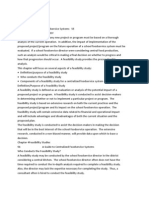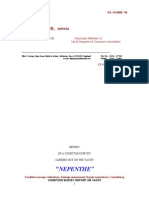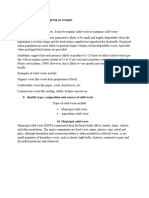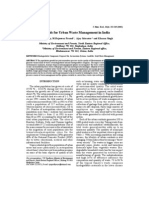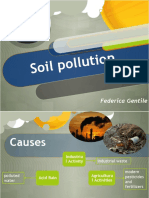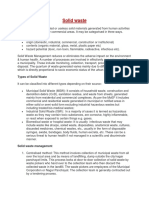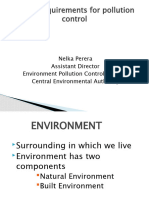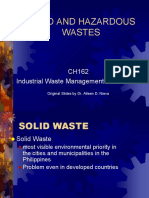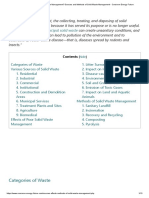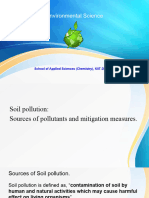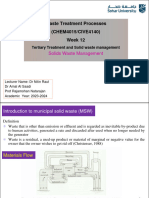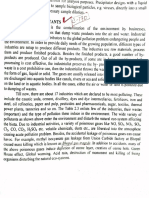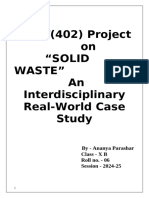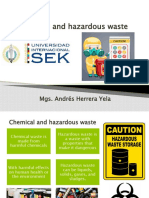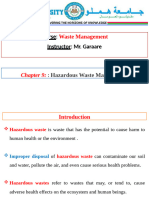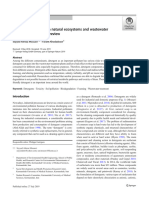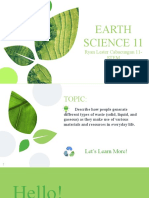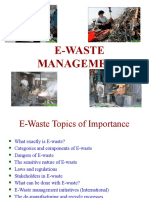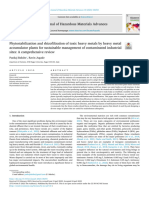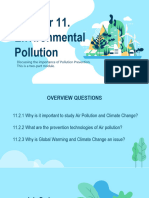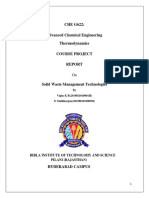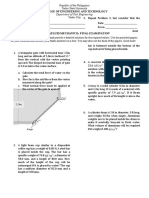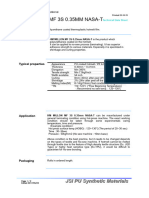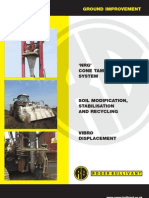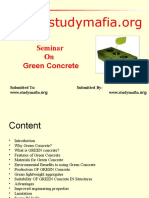Hazardous Waste Management: A Review of Principles and Methods
Hazardous Waste Management: A Review of Principles and Methods
Uploaded by
viqrisyam rizkyCopyright:
Available Formats
Hazardous Waste Management: A Review of Principles and Methods
Hazardous Waste Management: A Review of Principles and Methods
Uploaded by
viqrisyam rizkyOriginal Description:
Original Title
Copyright
Available Formats
Share this document
Did you find this document useful?
Is this content inappropriate?
Copyright:
Available Formats
Hazardous Waste Management: A Review of Principles and Methods
Hazardous Waste Management: A Review of Principles and Methods
Uploaded by
viqrisyam rizkyCopyright:
Available Formats
International Journal of Advanced Academic Research | Sciences, Technology & Engineering | ISSN: 2488-9849
Vol. 3, Issue 8 (August 2017)
HAZARDOUS WASTE MANAGEMENT: A REVIEW OF
PRINCIPLES AND METHODS
C.C. AMADI, O.C. OKEKE & D.C. AMADI
Department of Geology,
Federal University of Technology, Owerri, Imo State, Nigeria
Chichindu14@yahoo.com
ABSTRACT
Hazardous Waste Management entails procedures and policies carried out to deal with
hazardous waste in a way that will not pose problems to man and the environment. A
sustainable hazardous waste management system involves waste control from cradle to final
disposal and even pollution monitoring. This paper summarizes principles of different waste
disposal methods namely: Secure landfill, Deep-well injection and Bedrock disposal.
Keywords: Hazardous Waste, Toxic substances, Health Risk, Disposal Methods
Worldwide Knowledge Sharing Platform | www.ijaar.org Page 1
International Journal of Advanced Academic Research | Sciences, Technology & Engineering | ISSN: 2488-9849
Vol. 3, Issue 8 (August 2017)
1.0 INTRODUCTION
Industry has become an essential part of modern society, and hazardous waste production is
an inevitable outcome of developmental activities. A material becomes waste when it is
discarded without expecting to be compensated for its inherent value (Misra, 2015). These
wastes may pose a potential hazard to human health or the environment (soil, air, water)
when improperly managed.
Hazardous wastes are wastes or combination of wastes that pose a substantial present or
potential hazard to humans or the environment, in part because they are not degradable,
persistent in the environment and are deleterious to human health or natural resources
(RCRA, 2016).
Hazardous Waste Management is a process that involves the collection, recycling, treatment,
transportation, disposal, and monitoring of wastes disposal sites. Currently, in most
developing and transition countries, hazardous wastes often are disposed off indiscriminately
posing health and environmental risk. Increasingly, governments and international agencies
are attempting to control the growing problem of hazardous substances in the environment
which proves difficult because there are so many sources through which they are released.
So many toxic and hazardous substances emanate from these sources either purposefully or
accidentally contaminating, the land, air, and water (Enger, 2004). The potential health
effects of these substances range from minor, short term discomforts, such as headaches and
nausea to serious health problems, such as cancers and birth defects (that may not manifest
themselves over years), to major accidents that cause immediate injury or death.
According to Roger et al., (1989), proper control of hazardous wastes does cost money, but
experience in a number of developed countries suggests that cleaning up the “sins of the past”
is much more expensive in the long term. For instance, in the United States, cleanup of
improperly managed wastes has been estimated to cost 10-100 times as much as proper early
management. It is therefore important that all developing countries institute controls over
hazardous wastes to avoid excessive costs in the future.
In view of this, management of hazardous wastes including their disposal in environment
friendly and economically viable way is very important and therefore suggestions are made
considering the waste types and states (Solid or liquid).
2.0 SOURCES OF HAZARDOUS WASTES AND THEIR EFFECTS ON THE
ENVIRONMENT.
2.1 SOURCES OF HAZARDOUS WASTES
Most hazardous wastes are produced from a wide range of sector mainly in the manufacturing
of products for consumption or further industrial application. These include and not limited
to: Agricultural land and agro industry, domestic/household, mines and mineral processing
sites, health care facilities, commercial sites, institutional, industrial, solid waste disposal
sites, contaminated sites, building materials and activities that involve radioactive elements.
Worldwide Knowledge Sharing Platform | www.ijaar.org Page 2
International Journal of Advanced Academic Research | Sciences, Technology & Engineering | ISSN: 2488-9849
Vol. 3, Issue 8 (August 2017)
Table 1 shows the widespread distribution of hazardous wastes. Many sectors of the economy
are victims of hazardous wastes production whether directly or /and indirectly. Some
industries lack the capacity and capability to properly handle these wastes; they resort to
indiscrimate disposal as the only way to avoid costs and procedures associated with proper
management.
Table 1: Some hazardous wastes sources (Modified from Roger et al., 1989).
Sector Source Hazardous Wastes
Agricultural land and Farms Pesticides,fertilizers, and
agro-industry hazardous veterinary
product wastes
Health care centers Hospitals,clinics and medical Pathological
laboratory wastes,infectious
needles,contaminated
blood.
Commercial wastes Gasoline stations, dry cleaners and Waste oils,hydraulic
automobile repair and servicing shops fluids,halogenated
(workshops),airports,municipal solvents,polychlorinated
parks,Electrical transformers Biphenyls.
Industrial Hazardous Petroleum fuel Refining products (fuels
Wastes and tar), impurities like
phenol and cyanides in the
waste stream, and sludge
flushed from the storage
tanks.
Small scale industry Metal treating(electro- Acids,heavy metals
plating,etching,anodizing,galvanizing),
Photofinishing Solvents,acids,silver
Textile processing Cadmium,mineral acids
Printing Solvents,inks and dyes
Leather tanning. Solvents,chromium.
Large Scale industry Bauxite processing Red muds
Oil refining Spent catalysts
Petrochemical manufacture Oily wastes
Chemical/pharmaceutical manufacture Tarry residues, solvent
Chlorine production Mercury.
Building and Roofing Building and roofing materials Materials made of asbestos
Industries and copper
Mines and Mineral Uranium mining and processing Spent reactor
processing, Electricity rods,cloths,rags and wood
generating companies
Worldwide Knowledge Sharing Platform | www.ijaar.org Page 3
International Journal of Advanced Academic Research | Sciences, Technology & Engineering | ISSN: 2488-9849
Vol. 3, Issue 8 (August 2017)
Some of these substances are classified as probable human carcinogens and are associated
with increased tumor rates, organ damage and even death in man.
2.2 EFFECTS OF HAZARDOUS SUBSTANCES ON THE ENVIRONMENT
2.2.1. GENERAL STATEMENT
Today, because of increased urbanization and industrialization, some communities are
threatened with pollution caused by improper disposal of hazardous wastes (solid/liquid),
and these wastes can adversely affect the physical, mental and social health of the inhabitants
(Etim,2003).
2.2.2 EFFECTS ON LAND
Pollution resulting generally as a result of man‟s activities affects both crops, animal and
human health, and also the quality of the whole environment. Thus it is any process carried
out by man which leads to an adverse change in terrestrial environment. The dumping of
refuse could be termed the defacement of land and subsequent rendering of the soil non-
productive and polluted. Hazardous wastes dumped on land sites, when it rains, the leachates
from such refuse dumps contain various contaminants, the most harmful being heavy metals,
dissolved organic compounds, and nitrogen.
Deteriorating soil quality and decrease in vegetation abundance are also grave consequences
of open waste dumping which have resulted in growing public concern (Dawsin, 2000).
Figures 1 and 2 show indiscriminate ancient disposal methods called “open dumps”. Open
dumps in addition to other effects mentioned earlier lead to deteriorating soil quality and
decrease in vegetation abundance.
Environmental contamination by components of refuse such as heavy metals like cadmium,
lead, zinc and copper has been of great concern in the last decades because of their health
hazards to man and other organisms; when accumulated within a biological system. The
response of plants to pollutants is especially important since many of these plants are more
sensitive than the organisms.
Worldwide Knowledge Sharing Platform | www.ijaar.org Page 4
International Journal of Advanced Academic Research | Sciences, Technology & Engineering | ISSN: 2488-9849
Vol. 3, Issue 8 (August 2017)
Figure 1: Open dumps-Mixed wastes. (John, 2013)
Figure 2: Open dumps-empty used oil drums. (Anderson, 2011)
This is why plants usually serve as the most sensitive indicators as prolonged exposure to
them may destroy a large number of plants communities. Toxicity can result from a high
concentration of an element nutrient intake and can also give rise to abnormal growth, disease
or even death.
Also refuse dumps serve as breeding places for diseases-causing organisms such as rats and
flies which are the major disease vectors associated with garbage (Figures 1 &2). Rats, with
Worldwide Knowledge Sharing Platform | www.ijaar.org Page 5
International Journal of Advanced Academic Research | Sciences, Technology & Engineering | ISSN: 2488-9849
Vol. 3, Issue 8 (August 2017)
the assistance of flies are known to be involved in the spread of bubonic plague and urine
typhoid fever to humans. Rats may contaminate food with their urine,transmitting
leptospirosis, lasa fever and infectious hepatitis. They can transmit salmonella and other
intestinal organisms.
Also, hazardous wastes spoil the natural beauty of the land and may interfere with
recreational activities. Hazardous solid wastes can also produce unpleasant smell. The free
flow of traffic along our streets could also be hindered by the indiscriminate dumping of solid
hazardous wastes and can occupy land space that could have been used for other purposes as
seen in figures 1&2. Solid waste has the potential to cause sickness and even death. Therefore
proper waste management in any society is a matter of urgent attention.
Inherent changes in the application of industrial sludge to land due to contaminations with
heavy metals and possible presence of pathogens in raw sludges cause its prohibition in
agricultural lands. Chronic cadmium poisoning causes damage to kidney and heart. Prolong
exposure also results in loss of calcium from the bones,which then become brittle and easily
break. In japan for example, a whole village was striken by cadmium poisoning-known as
“Itai-Itai” disease after effluents contaminated rice supplies. Other heavy metals and
hazardous substances of interest are Copper, Chromium, Zinc, Lead, Arsenic, and Mercury
and Selenium, etc and their effects on man are shown on table 2 below
Table 2: Effects of heavy metals and substances on the Environment (Modified after Fordyce,
2000)
Heavy Source Toxicity
Metals/Substances
Cadmium (Cd) Textile Processing Renal and heart diseases, weakens bones
and tumors.
Lead (Pb) Mines and mineral processing Neurological disorders, convulsions,
companies kidney and brain damage
Mercury (Hg) Chlorine Production Neurological disorders, irritability and
liver damage
Arsenic (As) Metal treating(electro-plating, Cancer, skin diseases and poisoning
etching, anodizing, galvanizing
Zinc (Zn) Building and roofing materials Enzymes and skin disorders
Copper (Cu) Building materials made of copper Gastrointestinal irritant, liver damage
Selenium (Se) Photographic devices, gun cleaning Hair loss, nervous disorders.
solutions, plastics, paints, anti-
dandruff shampoos, vitamin and
mineral supplements, fungicides and
some types of glass.
Vinyl chloride Plastics manufacturing. Air or water Acute effects: dizziness, headache,
at contaminated sites unconsciousness, death
Chronic effects: liver, lung, and
Worldwide Knowledge Sharing Platform | www.ijaar.org Page 6
International Journal of Advanced Academic Research | Sciences, Technology & Engineering | ISSN: 2488-9849
Vol. 3, Issue 8 (August 2017)
circulatory damage.
Polychlorinated Eating contaminated fish, Industrial Probable carcinogens; acne and skin
biphenyls (PCB)s exposure lesions
Benzene Industrial exposures. Glues, cleaning Acute effects: drowsiness, headache,
products, gasoline death at high levels. Chronic effects:
damage to blood-forming tissues and
immune system; also carcinogenic
Benzo[a]pyrene Product of combustion of gasoline or Probable carcinogen; probable birth
other fuels. In smoke and soot defects
Polycyclic aromatic Exposure to smoke from a variety of Probable carcinogen; possible birth
hydrocarbons sources defects
Benzo[b]fluoranthene Product of combustion of gasoline Probable carcinogen
and other fuels inhaled in smoke
Chloroform Contaminated air and water. Many Affects central nervous system, liver, and
kinds of industrial settings kidneys; probable carcinogen
DDT From food with low levels of Probable carcinogen, possible long term
contamination. Still used as pesticide effect on liver; possible reproductive
in parts of world problems.
Trichloroethylene Used as a degreaser, evaporates into Dizziness, numbness, unconsciousness,
air death
Dibenz[a,h]anthracene Product of combustion in smoke Probable carcinogen
2.2.3 EFFECTS ON WATER
It is a generally accepted fact that the developed countries suffer from problems of chemical
discharge into water sources mainly groundwater, while developing countries face problems
of agricultural run-off in water sources. On top of these concerns, contamination of water is a
big concern after a natural disaster (e.g., tsunamis, earthquakes, hurricanes, floods, and
volcanoes) and can influence water quality on a grand scale (Okeke and Udoka, 2014).
Secure landfills may not be totally secure even if conscientiously designed. Carefully
compacted clay may be very low in permeability but is probably never completely
impermeable, especially over long time intervals (Montgomery, 2000). Chemical and
biological reactions in the wastes and leachate can rupture or decompose plastic, and the
stress caused by the weight of wastes and cover can fracture a clay liner. Leakage from
„secure‟ toxic waste dumps, in which hundreds or thousands of barrels of concentrated toxic
liquid chemicals are stored, has far more potential for harm. Leakage of at least certain
volatile organic compounds deemed high priority toxic pollutants like benzene, toluene, vinyl
chloride and chloroform have been detected by monitoring wells, e.g „Mount Trashmore‟
Landfill in Evanston, Illinois. These pollutants have been confirmed to cause adverse health
problems to man. Prevalent high rainfall and shallow water table accentuate problems of
pollution from landfills.
Worldwide Knowledge Sharing Platform | www.ijaar.org Page 7
International Journal of Advanced Academic Research | Sciences, Technology & Engineering | ISSN: 2488-9849
Vol. 3, Issue 8 (August 2017)
Our water supply is threatened with the presence of asbestos particles, heavy metals like
Lead, Cadmium, Arsenic, nitrates and sodium, a variety of chemicals that are known to be
carcinogens. Almost all the millions of tons of chemicals improperly disposed off on land
will sooner or later find their way to the underground water aquifers if they are fully
biograded. These chemicals include toxic synthetic organic chemicals developed with the
explosive growth of chemicals and petrochemicals since World War 11 such as
Trichloroethane, tetrachloroethane, venylchloride, 1,1,2 - trichloroethane, carbon
tetrachloride, benzene, xylene, toluene, and methylene chloride.
Some of these substances are essential to the body in trace amounts, mainly for synthesizing
enzymes, but it can be toxic in large amounts. According to the “Doctor‟s complete guide to
Vitamins and minerals, ”the tolerable upper intake level of selenium is set at 400mcg daily,
with 800mcg daily potentially causing toxicity and a dose of 5mg considered lethal for most
people. Selenium poisoning has no known antidote, so recognition of the signs and symptoms
is essential for survival (Bond, 2016).
Most of these chemicals are petroleum based and are found in gasoline (petrol) septic tank
cleaners, deodorants, plastics, spot removers, household cleaners, disinfectants, paints and
varnish removers, dry cleaning fluids and degreasing agent etc. These polluting chemicals
find their ways to the ground water in many ways-principally by seeping into aquifers from
landfills and waste dumps where chemicals are routinely dumped. They also come from
septic tanks of sub-urban, urban and rural homes and from ruptured homes, underground
petrol and fuel oil storage tanks. There is no easy solution to the polluted aquifers.
Restoration is almost impossible; once contaminated, the ground water remains so. Once the
chemicals reach the deep recesses of aquifers, they congeal together and their pollutants grow
in size and height yearly depending on the shape and composition of the geological structures
in the aquifer.
The solution to this problem is that of drilling into deeper less contaminated aquifer. There is
no guarantee that the toxic substances in aquifer near the surface will not reach the lower
ones. Aeration of the water is another method. Hence the contaminated water is drawn up
from the aquifers, passed through a cooling tower and then sprayed by nozzles into the air. In
this way, many of the volatile toxic chemicals evaporate before the water hits the ground
again and seeps into the aquifer.
Cancers, arthritis, skin irritation, heart disease, damage to the central nervous system, skin
rashes, kidney problems and bronchitis etc are the diseases associated with water pollution by
chemicals. The amount of contaminated water that can cause sickness to its consumer
depends on concentration and composition of the contaminant chemicals.
Worldwide Knowledge Sharing Platform | www.ijaar.org Page 8
International Journal of Advanced Academic Research | Sciences, Technology & Engineering | ISSN: 2488-9849
Vol. 3, Issue 8 (August 2017)
2.2.3.1 WATER-BORNE DISEASES/HEALTH HAZARDS OF WATER POLLUTION
Water-borne diseases are infectious diseases spread primarily through contaminated water.
Though these diseases are spread either directly or through flies or filth, water is the chief
medium of spread of these diseases and hence they are termed as water borne diseases.
Many areas of underground and surface water are now contaminated with heavy metals,
POPs (persistent organic pollutants), and nutrients that have an adverse effect on health.
Water- borne diseases and water-caused health problems are mostly due to inadequate and
incompetent management of water resources.
Generally, exposure to polluted water can cause diarrhea and infections to intestine,
respiratory problems, and increases incidence of tumour ,ulcers due to nitrate pollution, skin
disorders/irritations due to contact with pollutants, and increased incidence of constipation.
Blue baby caused by methane globinemia, reduced activity of immune system, loss of
memory and reduced sharpness, jaundice, hepatitis etc will be more prevalent. Eating animals
that are high in the food chain can increase exposure to xenoestrogens. For example, eating
large fish that survived by eating smaller ones. This is because, microscopic creatures eat
algae already been contaminated with the chemicals from polluted water, so they accumulate
the chemicals in their bodies. Xenoestrogens accumulate in fatty tissues, which means that
each animal in the food chain substantially increases its xenoestrogen levels by eating smaller
animals. Since we are on top of the food chain, we are most likely to be affected.00000
2.2.4 EFFECTS ON AIR
Apart from health problems caused by contamination of drinking water, toxins can seep into
buildings built above hazardous wastes sites, causing indoor air problems, respiratory
diseases and chemical sensitivity. Incinerating hazardous wastes can introduce mercury and
dioxin pollutants into the environment which can affect the lungs.
2.3 HAZARDOUS WASTE EXPOSURE PATHWAYS
The different ways a person can come into contact with hazardous chemicals are called
exposure pathways. One exposure pathway is inhalation, while others are ingestion and skin
contact. Exposure can occur when people breathe in hazardous chemical vapour or air that is
contaminated by hazardous chemicals or dusts. Ingestion is taking something in by mouth.
Skin contact occurs when something comes in direct contact with the skin. Ingestion can be a
secondary exposure pathway after skin contact has occurred, if you put your hands in your
mouth and transfer the chemical from your hands to your mouth. People can be exposed to
hazardous chemicals through the food they eat. Food contamination can occur if the food has
come into contact with hazardous chemicals. It can also occur further down the food chain
such as through eating contaminated fish (Duan, et al., 2011).
Worldwide Knowledge Sharing Platform | www.ijaar.org Page 9
International Journal of Advanced Academic Research | Sciences, Technology & Engineering | ISSN: 2488-9849
Vol. 3, Issue 8 (August 2017)
3.0 PRINCIPLES AND METHODS OF HAZARDOUS WASTE MANAGEMENT
3.1 PRINCIPLES
Hazardous waste management is the general term given to the procedures and policies carried
out to deal with hazardous waste in a way that will not pose problems to man and the
environment.
Originally, hazardous wastes were commonly disposed of by open dumping, open burning, or
incineration. Open dumping can contribute to land litter and water pollution, and the end
products of open burning and incineration can contribute to air pollution in the form of
particulates, nitrogen oxides, noxious odors, and other constituents. In addition, the burning
process can produce solid residues which when ultimately disposed can contribute to water
pollution and even help to create some small amounts of methane gas. Municipal incineration
with sophisticated energy recovery systems were popular in large European and American
cities at the turn of the century, but became extinct due to high operating costs. Similarly, in
former years, garbage was reclaimed for hog feed; animal wastes were rendered for fats to
manufacture soap and other products. These practices have become less popular because of
public health requirements to sterilize garbage, and because of the economies of mixed refuse
collection. However, the recovery of paper, metals, and other solid wastes continues to be
practiced by scrap dealers whenever economically feasible. In recent years, hazardous solid
waste incineration has become less popular because of greatly increased air pollution control
requirements.
According to Iyyanki and Vali (2017), hazardous waste management is a major challenge in
urban areas throughout the world. Without an effective and efficient waste management
program, the waste generated from various human activities both industrial and domestic, can
result in health hazards and have negative impact on the environment.
The following procedure forms a standard waste management strategy in a developed society.
Each step play a very important role in ensuring that waste disposal which is the final stage in
the management process is achieved without threat to man and the environment.
Worldwide Knowledge Sharing Platform | www.ijaar.org Page 10
International Journal of Advanced Academic Research | Sciences, Technology & Engineering | ISSN: 2488-9849
Vol. 3, Issue 8 (August 2017)
3.2 HANDLING OF HAZARDOUS WASTES:
Persons handling hazardous wastes are advised to wear respiratory protection, hand and skin
protection, eye protection and protective clothing to reduce the effect of contact. Hazardous
wastes can cause dermatitis to the skin, some cause asthma on long exposure, others cause
the eyes to smart and run and also tightening of the chest.
3.3 TRANSPORT OF HAZARDOUS WASTE
Hazardous waste generated at a particular site often requires transport to an approved
treatment, storage, or disposal facility (TSDF). Because of potential threats to public safety
and the environment, transport is given special attention by governmental agencies. In
addition to the occasional accidental spill, hazardous waste has, in the past, been intentionally
spilled or abandoned at random locations in a practice known as “midnight dumping.” This
practice has been greatly curtailed by the enactment of laws that require proper labeling,
transport, and tracking of all hazardous wastes (Jerry, 2015).
When hazardous wastes are transported off-site for disposal, the waste generator prepares a
shipping document called a manifest. This form must accompany the waste to its final
destination and used to track the waste‟s movements from „cradle to grave‟.
In the event of a leak or accidental spill of hazardous waste during its transport, the
transporter must take immediate and appropriate actions, including notifying local authorities
of the discharge. An area may have to be diked to contain the wastes, and efforts must be
undertaken to remove the wastes and reduce environmental or public health hazards.
3.4 . WASTE MINIMIZATION, TREATMENT AND DISPOSAL.
3.4.1 WASTE MINIMIZATION/REDUCTION AND RECYCLING
Waste minimization is a very important hazardous waste management strategy in developing
countries. The concept of waste minimization can best be illustrated by means of Figure 3
which subdivides the strategy into three headings: Source reduction, recycling, and treatment.
Worldwide Knowledge Sharing Platform | www.ijaar.org Page 11
International Journal of Advanced Academic Research | Sciences, Technology & Engineering | ISSN: 2488-9849
Vol. 3, Issue 8 (August 2017)
HAZARDOUS WASTE GENERATION PROCESS(ES)
Source Reduction Recycling Treatment
Any activity that reduces or Any activity that reduces volume Any activity that reduces
eliminates the generation of and /or toxicity of hazardous waste volume and /or toxicity of
hazardous waste within a process with attendant generation of a hazardous waste without
valuable material which is attendant generation of a
subsequently utilized valuable material
(a) Volume reduction –preferable accomplished without an increase of toxicity
(b) Toxicity reduction-preferable accomplished by means other than dilution
Figure 3: Hazardous Waste Control through Reduction. (Modified from Roger,et al.,
1989).
RECYCLING AND RECOVERY: Viewed generically “recycling” encompasses both re-
use and reclamation activities. Many hazardous wastes can be recycled into new products.
Examples might include lead-acid batteries or electronic circuit boards, where there are heavy
metals, after burning, these types of ashes go through the proper treatment, they could bind to
other pollutants and convert them into easier-to- dispose solids, or they could be used as
pavement filling. Such treatments reduce the level of threat of harmful chemicals, like fly and
bottom ash while also recycling the safe product.
Hazardous waste recycling is divided into two namely; materials recovery as well as energy
recovery .A recycler‟s decision as to how to treat a waste is principally determined by the
character of specific waste streams or waste mixtures. Where treatment should take place
(either onsite or offsite however, is a function of a generator‟s management practices which
include:
Proximity to offsite recycling facilities
Economic costs related to the transportation of wastes
The volume of wastes available for processing, and
Worldwide Knowledge Sharing Platform | www.ijaar.org Page 12
International Journal of Advanced Academic Research | Sciences, Technology & Engineering | ISSN: 2488-9849
Vol. 3, Issue 8 (August 2017)
Costs related to storage of waste onsite to offsite.
Recycling is characterized by three major practices:
1. Direct use or re-use of a waste in a process.
2. Recovery of a secondary material for a separate end use such as the recovery of a
metal from a sludge
3. Removal of impurities from a waste to obtain a relatively pure re-usable substance
Although recycling of selected wastes is practiced to a considerable degree by certain
industries, only a small percentage of the hazardous waste is being recycled. A greater
percentage of wastes are being recycled onsite. Offsite recycling however has become
increasingly common with the advent of commercial recyclers and direct transfer of waste
from generators to others who can re-use the wastes. Most flammable materials can be
recycled, used as industrial fuel. Some materials with hazardous constituents can be recycled,
lead acid batteries are one example.
Recycled wastes are used as feedstocks in production processes or as substitutes for
commercial chemical products. Examples include:
The re-use of solvents for equipment cleaning;
The recycling of collected pesticide dusts at pesticides formulators; and
The re-use of ferric chloride wastes from titanium dioxide manufacturing as a
wastewater conditioner in water treatment.
In the 1981 U.S. survey, data indicate that recycling for materials recovery and re-use appears
to be more popular than fuel use or energy recovery. Reasons are, first, some wastes that
could be recycled for energy recovery can also be reclaimed and re-used over and over.
Energy recovery in contrast destroys the inputs. Only when the waste is too ”dirty”
(contaminated from repeated re-use) do operators consider energy recovery a desirable
option. The 1981 data may not, however, provide a completely accurate picture of current
practices because of recent developments in energy recovery technology. Many technologies
were not available in 1981, and others are only beginning to be commercially available today.
Solvents tend to be used for energy recovery because they can possess high energy values.
Increasing quantities of high calorific wastes are being used by cement plants and lime kilns.
3.4.2. WASTE TREATMENT AND DISPOSAL
3.4.2.1. TREATMENT
While reduction and recycling are desirable options, they are not regarded as the final remedy
to the problem of hazardous-waste disposal. There will always be a need for treatment, and
Worldwide Knowledge Sharing Platform | www.ijaar.org Page 13
International Journal of Advanced Academic Research | Sciences, Technology & Engineering | ISSN: 2488-9849
Vol. 3, Issue 8 (August 2017)
for storage before the final disposal of some amount of hazardous waste. Hazardous waste
can be treated by chemical, thermal, biological, and physical methods.
Hazardous waste is the most difficult waste to manage, since in the treatment process, heavy
metal and dioxin among others are obtained. The outcome elements are dangerous not only
for the environment but also for public health (Couto, et al., 2013).
3.4.2.2. DISPOSAL
Disposal of hazardous waste is the final stage of a hazardous waste management system.
Almost all possible disposal methods necessitate proper pre-treatment, in order to have secure
disposal facilities (Visvanathan, 1996). Summaries of selected principles of different waste
disposal methods are emphasized in this work namely: Secure landfill, Deep well and
Bedrock disposal.
(a) SECURE LANDFILLS
Historically, some hazardous wastes were disposed of in regular landfills. This resulted in
unfavorable amounts of hazardous materials seeping into the ground. These chemicals
eventually enter natural hydrologic systems. Many landfills now require countermeasures
against groundwater contamination, an example being installing a barrier along the
foundation of the landfill to contain the hazardous substances that may remain in the disposed
waste. Currently, hazardous wastes must often be stabilized and solidified in order to enter a
landfill and many hazardous wastes undergo different treatments in order to stabilize and
dispose of them.
A landfill is a disposal facility where hazardous wastes are placed into and stored in the soil.
Landfills for hazardous wastes are frequently considered a technology of last resort to be used
after every effort has been made to reduce or eliminate the hazards posed by the waste. The
intent is to bury or alter the wastes so that they are not environmental or public health
hazards.
For some years, waste disposal specialists have believed that, in principle, it is possible to
design a secure landfill site for hazardous liquid wastes. An example of a recommended
design is shown in Figure 4. The wastes are put in sealed drums before disposal. A secure
hazardous-waste landfill must have two impermeable liners and leachate collection systems.
Worldwide Knowledge Sharing Platform | www.ijaar.org Page 14
International Journal of Advanced Academic Research | Sciences, Technology & Engineering | ISSN: 2488-9849
Vol. 3, Issue 8 (August 2017)
Figure 4: A secure landfill design for hazardous waste disposal (Encyclopedia Britannica,
2016)
The double leachate collection system consists of a network of perforated pipes placed above
each liner. The upper system prevents the accumulation of leachate trapped in the fill, and the
lower serves as a backup. Collected leachate is pumped to a treatment plant. In order to
reduce the amount of leachate in the fill and minimize the potential for environmental
damage, an impermeable cap or cover is placed over a finished landfill.
In view of the above precaution to prevent leachates from accumulating in landfills, there
isn‟t any complete guarantee that leachate would not accumulate no matter how secure the
landfill is engineered.
The main components in the leachate from landfill sites may be conveniently grouped into
four classes, as follows:
a) Major elements and ions such as calcium, magnesium, iron, sodium, ammonia,
carbonate, sulphate and chloride.
b) Trace metals such as mangenese, chromium, nickel, lead, and calcium;
c) a wide variety of organic compounds which are usually measured as Total Organic
Carbon (TOC) or Chemical Oxygen Demand (COD); individual organic species such
as phenol can also be of concern; and
d) Microbiological components
All hazardous waste and most industrial waste will give rise to leachate.
Heavy metals have been of greater concern compared to other leachate components; this is as
a result of its persistent and bio-accumulative nature in the food chain. Fossil fuel
combustion, metallurgical industrial activities and industrial wastes generation are the main
Worldwide Knowledge Sharing Platform | www.ijaar.org Page 15
International Journal of Advanced Academic Research | Sciences, Technology & Engineering | ISSN: 2488-9849
Vol. 3, Issue 8 (August 2017)
sources of heavy metals‟ wastes generation, and also poor management by generators over
years have accentuated their unwarranted release to the environment.
(b) DEEP-WELL DISPOSAL: Another alternative disposal of liquid industrial waste is
injection into deep wells (Figure 5).Deep well injection is a liquid waste disposal technology.
This alternative uses injection wells to place treated or untreated liquid waste into geologic
formations that have no potential to allow migration of contaminants into potential potable
water aquifers. This method has been practiced since World War 11 and involves pumping
liquid waste through a steel casing into a porous layer of limestone or sandstone. High
pressures are applied to force the liquid into the pores and fissures of the rock, where it is to
be permanently stored. The rock unit selected to receive the waste must be relatively porous
and permeable (commonly, sandstone or fractured limestone), and it must be isolated by low-
permeability layers (for example, shale) above and below. The subsurface geology must be
known in sufficient detail that there is reasonable confidence that the disposal stratum
remains isolated for some distance from the well site in all directions. Information about that
geology may be derived from many sources: direct drilling to obtain core samples that
provide a vertical section of the rock units present; geophysical studies that provide data on
depths to and thicknesses of different rock layers, and on distribution of ground water;
geologic mapping on the basis of cores, surface outcrops, and geophysical data to interpolate
between points sampled directly.
Figure 5: Deep well disposal method (Source; Linday, 2012)
These disposal wells are hundreds to thousands of meters deep, far removed from the
surface, and below the regional water table. The pore water in the disposal stratum should be
brackish or saline water not suitable for a water supply. Where the well intersects any
shallower aquifer that are or might be used for water supply, it must be snugly lined (cased)
Worldwide Knowledge Sharing Platform | www.ijaar.org Page 16
International Journal of Advanced Academic Research | Sciences, Technology & Engineering | ISSN: 2488-9849
Vol. 3, Issue 8 (August 2017)
to prevent leakage of the wastes into those aquifers. Local well water is monitored to detect
any accidental leaks promptly.
Movement of deep ground water is generally slow, and the assumption is that, by the time the
toxic chemicals have migrated far enough laterally to reach a usable aquifer or another body
of water, they will have become sufficiently diluted not to pose a threat. This presumes
knowledge of the toxicity of the chemicals in low concentrations. When the wastes are more
or less dense than the ground water, they displace and not miscible with it, folds or other
geologic structure may help to contain them and slow their spread, as oil traps contain
petroleum. The behaviour of chemicals that dissolve in pore water is much less well
understood. They can diffuse through the water more rapidly than the water itself moves, so
that even if deep ground water transport is slow, contaminant migration may not be.
Deep-well injection is relatively inexpensive and requires little or no pretreatment of the
waste, but it poses a danger of leaking hazardous waste and eventually polluting subsurface
water supplies.
(c) BEDROCK DISPOSAL
Figure 6: Bedrock disposal of solid hazardous wastes (Source: Rajakumar, 2016)
A variety of bedrock types are being investigated as host rocks for solid hazardous waste. The
general design of a bedrock disposal site or repository for such wastes is shown in Figure 6. It
involves the multiple barrier (or multi barrier) concept: surrounding solid waste with several
different types of materials to create multiple obstructions to waste leakage or invasion by
ground water. A major variable is the nature of the host rock as well as some potential
drawbacks. The waste forms envisaged for disposal are vitrified high-level radioactive wastes
Worldwide Knowledge Sharing Platform | www.ijaar.org Page 17
International Journal of Advanced Academic Research | Sciences, Technology & Engineering | ISSN: 2488-9849
Vol. 3, Issue 8 (August 2017)
sealed into stainless steel canisters, or spent fuel rods encapsulated in corrosion resistant
metals such as copper or stainless steel. The most widely accepted plans are for these to be
buried in stable rock structures deep underground. Many geological formations such as
granite, volcanic tuff, salt, thick basalts such as the Columbia River plateau basalt or shale
will be suitable (Salma, 2012).
4.0 CONCLUSION
The fundamental goal of hazardous waste management program is to change the behavior of
those who generate hazardous waste so that they routinely store, transport, treat, and dispose
of them in an environmentally safe manner. The focus comes in an effort to address more
immediate threats to public health, such as safe drinking water.
Hazardous waste management must move beyond burying and burning. Industries need to be
encouraged to generate less hazardous waste in their manufacturing processes. Although
toxic wastes cannot be entirely eliminated, technologies are available for minimizing,
recycling, and treating wastes. It is possible to enjoy the benefits of modern technology while
avoiding the consequences of a poisoned environment. The final outcome rests with
governmental and agency policy makers, as well as with an educated public.
Worldwide Knowledge Sharing Platform | www.ijaar.org Page 18
International Journal of Advanced Academic Research | Sciences, Technology & Engineering | ISSN: 2488-9849
Vol. 3, Issue 8 (August 2017)
REFERENCES.
Anderson,B.(2011).A formular for provision or perversion of Municipal Solid Waste
management. Retrieved from http://www.clearimpression.wordpress.com/page/5.
Bond,O.(2016). Signs and symptoms of selenium poisoning. Retrieved from
www.livestrong.com/article/367955-signs-symptoms-of-selenium-poisoning/
Couto, N., Silva, V., Monteiro, E., & Rouboa, A. (2013). Hazardous waste management in
Portugal: An overview. In Energy Procedia (Vol. 36, pp. 607–611).
https://doi.org/10.1016/j.egypro.2013.07.069
Dawsin,D.A.(2000). Alternative measures to Waste Disposal. Journal of Hazardous
Substance,12(1-2),79-91.
Duan,V.,Chen,Q.,Ye et al(2011). Hazardous Incidents. Journal of Hazardous Materials,
186(2—3), 1489-1494.
Encyclopedia Britannica,2016.Hazardous Waste Disposal.Retrieved from
https://www.britannica.com/technology/hazardous-waste-management
Enger, E.D & Smith, B.F.(2004). A study of interrelationships. Environmental Science.
Edward E. Bartell. Carlifornia,USA:
Etim, I.U. (2003). Basic Principles of Environmental Science. Etiliew International
Publishers.Uyo,Nigeria.
Fordyce, F.(2000). Geochemistry and Health. Geoscience and development,No 6 pp.6-88.
GESAMP(IMO)/FAO/UNESCO/WMO/WHO/IAEA/UN/UNEP.1982. Joint Group of
Experts on the Scientific Aspects of Marine Pollution: The Health of the Oceans.
Rep.Stud.,GESAMP,(15): 108p and UNEP Reg.Seas Rep.Stud.16,108pp.
Iyyanki,V.M., & Vali, M.(2017). Science and Engineering for industry. Thailand:Elservier
Inc.
Jerry, A.N., (2015). Encyclopedia Britannica, Hazardous Waste management.
John,V.(2014).Smelly and contaminated,the World‟s open dumps are growing.Retrieved
from https://www.thestar.com.my/lifestyle/features.htm.
Linday, D. P.( 2012).Deep Well Injection Waste Disposal technology. Retrieved from
http://www.theguardian.com.
Misra, V., & Pandey, S. D. (2005). Hazardous waste, impact on health and environment for
development of better waste management strategies in future in India. Environment
International. https://doi.org/10.1016/j.envint.2004.08.005
Worldwide Knowledge Sharing Platform | www.ijaar.org Page 19
International Journal of Advanced Academic Research | Sciences, Technology & Engineering | ISSN: 2488-9849
Vol. 3, Issue 8 (August 2017)
Montgomery, C.W. (2000). Environmental Geology (5th Ed.).Edward E.
Bartell.Carlifornia,USA.
Okeke, O.C.& Udoka, U.P. (2014). Handbook of Geologic Methods Vol.2. Platinum Global
Ventures Press. Port Harcourt,Nigeria.
Rajakumar, J.(2016). Solid and Liquid waste management in smart cities-phase 2. Retrieved
from https://www.slideshare.net/Jayanth-R/solid-and-liquid-waste-management-in-
smart-cities-phase-2
Roger, B., James, E.S., & David, D. (1989).The safe disposal of Hazardous wastes: The
special needs and problems of developing countries, A world Bank Technical paper 1
(93)154 Washington D.C: World Bank.
Roger, B., James, E.S., & David, D.(1989). The safe disposal of hazardous wastes: The
special needs and problems of developing countries. A world Bank Technical paper
2(93) pp 270-276,448-470) Washington D.C: World Bank
Salma,2012.Is zero waste possible? Retrieved from
http://www.global.britannica.com/topic/secure-landfill.
The Resource Conservation and Recovery Act(RCRA)(2016). Hazardous wastes regulations,
Chapters 10 through 32 of Division 4.5 of Title 22 of the California Code of
Regulations .Retrieved from
http://www.dtsc.ca.gov/HazardousWaste/upload/HWMP_DefiningHW111.pdf
Visvanathan, C. (1996). Hazardous waste disposal. In Resources, Conservation and
Recycling (Vol. 16, pp. 201–212). https://doi.org/10.1016/0921-3449(95)00057-7
Worldwide Knowledge Sharing Platform | www.ijaar.org Page 20
You might also like
- Introduction To Self-Driving Vehicle Technology (Hanky Sjafrie)Document255 pagesIntroduction To Self-Driving Vehicle Technology (Hanky Sjafrie)Poorvi Raddi100% (1)
- CSDT Template - MalaysiaDocument14 pagesCSDT Template - MalaysiaDaniel CamargoNo ratings yet
- Sample Feasibility StudyDocument39 pagesSample Feasibility StudyMycha P. EncarnacionNo ratings yet
- Martin Evans,: "Nepenthe"Document19 pagesMartin Evans,: "Nepenthe"Btwins123No ratings yet
- Managementul DeseurilorDocument14 pagesManagementul DeseurilorMatis AlexandruNo ratings yet
- Oromia Appendix c9 Oromia Waste Management PlanDocument10 pagesOromia Appendix c9 Oromia Waste Management Plansherazk330No ratings yet
- Solid Waste ManagementDocument24 pagesSolid Waste ManagementRizveNo ratings yet
- Iwre114 Assignment - 052042Document10 pagesIwre114 Assignment - 052042morgankiwanga99No ratings yet
- RA 6969 (Klad)Document47 pagesRA 6969 (Klad)Lilvic Galera-SabladNo ratings yet
- JHE18 4 253 269 2005 UpadhyayDocument17 pagesJHE18 4 253 269 2005 UpadhyayvpupadhyayNo ratings yet
- Workplace Hazards Ang Their Ill EffectdDocument110 pagesWorkplace Hazards Ang Their Ill EffectdJanissaries NivercaNo ratings yet
- Clean Techno ENglishDocument16 pagesClean Techno ENglishUPSC नगरियाNo ratings yet
- Soil Pollu Tion: Federica GentileDocument10 pagesSoil Pollu Tion: Federica GentileAnnaGentileNo ratings yet
- Study MaterialDocument113 pagesStudy MaterialUtkarsh SinghNo ratings yet
- Solid WastesDocument13 pagesSolid WastesDali MondalNo ratings yet
- WSP Waste Management Plan - SampleDocument10 pagesWSP Waste Management Plan - SampleMark Joseph AbelleraNo ratings yet
- Slsi Presentation On MondayDocument66 pagesSlsi Presentation On MondayGamini WeerasingheNo ratings yet
- Is4102 Environmental SaftyDocument169 pagesIs4102 Environmental SaftySabarish SubramaniamNo ratings yet
- Solid Waste ManagementDocument61 pagesSolid Waste ManagementRajeshwari DasguptaNo ratings yet
- CH162 Solid and Hazardous WastesDocument114 pagesCH162 Solid and Hazardous WastesAstra BeckettNo ratings yet
- What Is Solid Waste Management - Sources and Methods of Solid Waste Management - Conserve Energy FutureDocument13 pagesWhat Is Solid Waste Management - Sources and Methods of Solid Waste Management - Conserve Energy FutureBASKAR ENo ratings yet
- Soil PollutionDocument17 pagesSoil Pollutionaraj518181No ratings yet
- Marine Polution and BioremediationDocument29 pagesMarine Polution and BioremediationImanuel lpmukpNo ratings yet
- Week 12-CHEM4015-CIVE4140-2023-2024Document19 pagesWeek 12-CHEM4015-CIVE4140-2023-2024Nitin RautNo ratings yet
- Industrial Waste ClassificationDocument16 pagesIndustrial Waste ClassificationSinovuyo SibandaNo ratings yet
- 2.5. Industrial Pollutants - 1102: Dilution PollutionDocument5 pages2.5. Industrial Pollutants - 1102: Dilution PollutionHina AftabNo ratings yet
- Biomedical Hazardous WasteDocument25 pagesBiomedical Hazardous WasteMD IBRAHIMNo ratings yet
- Module 1 - Waste Types and ClassificationDocument10 pagesModule 1 - Waste Types and ClassificationAnurag KumarNo ratings yet
- Waste Managenent IDocument4 pagesWaste Managenent Imail2shanthithevarNo ratings yet
- Viwin Ppt Solid HazardousDocument74 pagesViwin Ppt Solid HazardousSivaprashadr Dr.NGP ItechNo ratings yet
- Envt Laws 2Document41 pagesEnvt Laws 2Akhilakhil AkhilNo ratings yet
- Final Module 4Document24 pagesFinal Module 4ShruthiRamchandraNo ratings yet
- It ProjectDocument26 pagesIt ProjectSunita MishraNo ratings yet
- Hazardous Waste Management in India - A Review: February 2018Document10 pagesHazardous Waste Management in India - A Review: February 2018Neha KumariNo ratings yet
- Hazardous Waste Management in India - A Review: February 2018Document10 pagesHazardous Waste Management in India - A Review: February 2018Neha KumariNo ratings yet
- (Pre-Final) Solid and Hazardous WasteDocument74 pages(Pre-Final) Solid and Hazardous WasteMarkNo ratings yet
- MODULE 4: Environmental Issues and Problems: Wastes and PollutionDocument34 pagesMODULE 4: Environmental Issues and Problems: Wastes and PollutionVINESSE JUMAWIDNo ratings yet
- Industrial, Air, Water Pollution: Vaughnette Erika B. Salimbagat Keziah Rose B. SalvadorDocument95 pagesIndustrial, Air, Water Pollution: Vaughnette Erika B. Salimbagat Keziah Rose B. SalvadorRustom IbanezNo ratings yet
- Chemical and Hazardous Waste: Mgs. Andrés Herrera YelaDocument12 pagesChemical and Hazardous Waste: Mgs. Andrés Herrera YelaAndres Herrera YelaNo ratings yet
- Hazardous Waste ManagementDocument24 pagesHazardous Waste ManagementShafie Osman AliNo ratings yet
- Detergensek Hatása A Környezetben És A Szennyvíztisztításban - ReviewDocument10 pagesDetergensek Hatása A Környezetben És A Szennyvíztisztításban - Reviewedit16No ratings yet
- World's Largest Science, Technology & Medicine Open Access Book PublisherDocument34 pagesWorld's Largest Science, Technology & Medicine Open Access Book Publishersangkil05No ratings yet
- Waste EARTH SCIENCE 11Document26 pagesWaste EARTH SCIENCE 11Harith Lee100% (1)
- Disaster Management: Environmental StudiesDocument9 pagesDisaster Management: Environmental StudiesImtiyaz KhanNo ratings yet
- EVS - Soil Pollution N Solidwaste ManagementDocument88 pagesEVS - Soil Pollution N Solidwaste Management22052724No ratings yet
- Residual Waste and Radioactive MaterialsDocument21 pagesResidual Waste and Radioactive MaterialsJoyce MendozaNo ratings yet
- Environmental Studies-Module 3Document36 pagesEnvironmental Studies-Module 3HarshithNo ratings yet
- CE-105 E-Waste - CE 105vcsDocument42 pagesCE-105 E-Waste - CE 105vcsAyushNo ratings yet
- RCM FinalDocument45 pagesRCM Finalsakethdandu628No ratings yet
- Air Pollution in Textile Industry: Meenaxi Tiwari Sudha BabelDocument3 pagesAir Pollution in Textile Industry: Meenaxi Tiwari Sudha Babelmoges asmelashNo ratings yet
- 1 s2.0 S2772416623000645 MainDocument16 pages1 s2.0 S2772416623000645 Mainahmadfareedchishti777No ratings yet
- Chapter 11 - Part 2 - Air Pollution and Climate ChangeDocument41 pagesChapter 11 - Part 2 - Air Pollution and Climate ChangeAngel RabayaNo ratings yet
- Waste Management Technologies PDFDocument15 pagesWaste Management Technologies PDFInkollu Sreedhar100% (1)
- Unit1-Solid Waste Management - 1Document11 pagesUnit1-Solid Waste Management - 13901 P Priyanka RathodNo ratings yet
- Summary of Expected WastesDocument1 pageSummary of Expected WastesBasem AlsaftliNo ratings yet
- Waste Management IntroductionDocument49 pagesWaste Management IntroductionAine JeremyNo ratings yet
- WastewaterDocument27 pagesWastewaterKeilah MizraimNo ratings yet
- Electronic WasteDocument3 pagesElectronic WastePurav BhadesiyaNo ratings yet
- Waste Management PAOMDocument13 pagesWaste Management PAOMPhalguni MuthaNo ratings yet
- Assignment 1 WastewaterDocument20 pagesAssignment 1 WastewaterFadzrilNo ratings yet
- Moringa Technology by Use of Moringa Oleifera As Bio-CoagulentDocument4 pagesMoringa Technology by Use of Moringa Oleifera As Bio-CoagulentJournalNX - a Multidisciplinary Peer Reviewed JournalNo ratings yet
- 82 Hazardous Waste ManagementDocument64 pages82 Hazardous Waste ManagementakashNo ratings yet
- Solid Waste ManagementDocument36 pagesSolid Waste ManagementKyla GatusNo ratings yet
- Solid Wastes ManagementFrom EverandSolid Wastes ManagementStephen BurnleyNo ratings yet
- Indirect Composite Inlays and OnlaysDocument3 pagesIndirect Composite Inlays and OnlaysmegamarwaNo ratings yet
- 172 173-Elementary Secondary School CounselorDocument5 pages172 173-Elementary Secondary School Counselorapi-659481757No ratings yet
- English HKSI LE Paper 12 Pass Paper Question Bank (QB)Document10 pagesEnglish HKSI LE Paper 12 Pass Paper Question Bank (QB)Tsz Ngong KoNo ratings yet
- Chemical Bonding: Vy Bui, Lalein A. PajarilloDocument10 pagesChemical Bonding: Vy Bui, Lalein A. PajarilloYuvaraj Tan Hong LeongNo ratings yet
- Environmental Engineering 2012Document3 pagesEnvironmental Engineering 2012SherifaNo ratings yet
- Program/Project Year-End Evaluation (Revised 2017) : QUALITY (50 PTS) PhaseDocument2 pagesProgram/Project Year-End Evaluation (Revised 2017) : QUALITY (50 PTS) PhaseHoneyjo NetteNo ratings yet
- George Robbins Considers Himself An Aggressive Investor He S Thinking AboutDocument1 pageGeorge Robbins Considers Himself An Aggressive Investor He S Thinking AboutAmit PandeyNo ratings yet
- Jul 1, 2011 Phillip Ragain, Ron Ragain, Michael Allen and Mike AllenDocument2 pagesJul 1, 2011 Phillip Ragain, Ron Ragain, Michael Allen and Mike AllenBusyBoy PriyamNo ratings yet
- Fluids Final ExamDocument1 pageFluids Final ExamJoshua Jay JetomoNo ratings yet
- Rapidard (Data Sheets)Document1 pageRapidard (Data Sheets)Ajidharma CorporindoNo ratings yet
- 18 Apr 20 AFRICAN FLAMINGO (9802322) IFO 380 (RMG 380) : Report Date Vessel Fuel GradeDocument4 pages18 Apr 20 AFRICAN FLAMINGO (9802322) IFO 380 (RMG 380) : Report Date Vessel Fuel GradeNguyễn Hữu DũngNo ratings yet
- TDS-HM Millon MF 3s 0.35mm, Nasa-T 0.20mm-20200116Document2 pagesTDS-HM Millon MF 3s 0.35mm, Nasa-T 0.20mm-20200116tranngocthuonghoaiNo ratings yet
- Ground Improvement BrochureDocument8 pagesGround Improvement BrochureNaherullaNo ratings yet
- QUESTIONSDocument6 pagesQUESTIONSMeow MeowNo ratings yet
- EqualityDocument39 pagesEqualityB. Ranu RaoNo ratings yet
- Confined Space Activities ChecklistDocument2 pagesConfined Space Activities ChecklistFaiz FalehNo ratings yet
- IGCSE Theory 0654 - s16 - QP - 22Document32 pagesIGCSE Theory 0654 - s16 - QP - 22nesrine boufadenNo ratings yet
- Nammazhvar College of Agriculture and Technology: (Affiliated To Tamil Nadu Agricultural University)Document6 pagesNammazhvar College of Agriculture and Technology: (Affiliated To Tamil Nadu Agricultural University)RudhranNo ratings yet
- Rotary SectionDocument36 pagesRotary SectionGustavo HurtadoNo ratings yet
- Human Parvovirus B19 in The Bone MarrowDocument3 pagesHuman Parvovirus B19 in The Bone MarrowKata TölgyesiNo ratings yet
- Coccyx PDFDocument5 pagesCoccyx PDFtechzonesNo ratings yet
- Question and Answer - 27Document30 pagesQuestion and Answer - 27acc-expertNo ratings yet
- Project Proposal - First Aid SeminarDocument2 pagesProject Proposal - First Aid SeminarAngelo FaustinoNo ratings yet
- Why Incentive Plan FailsDocument9 pagesWhy Incentive Plan FailsNoman KhanNo ratings yet
- Civil Green ConcreteDocument18 pagesCivil Green Concretesharukh88% (8)
- Ent Prac 1Document2 pagesEnt Prac 1lubaajamesNo ratings yet


